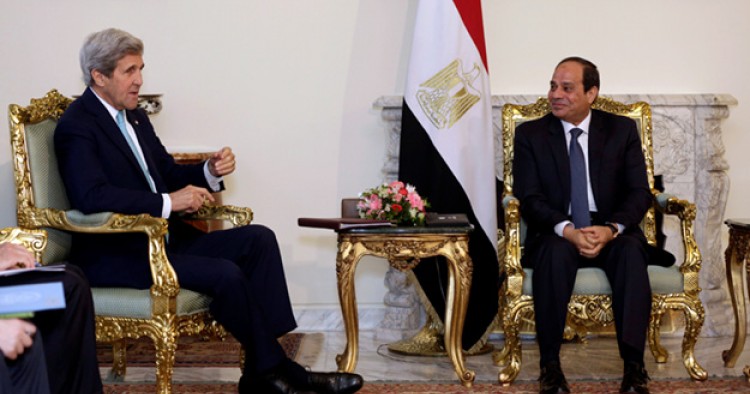This article was first published by Real Clear World.
Since the ISIS downing of a Russian airliner over Sinai in October 2015, there has been a bustle of activity between Washington and Cairo. U.S. Secretary of State John Kerry has been to the Egyptian capital twice, in addition to visits by high-level Congressional, military, intelligence, and business delegations. Despite continued high concern about the country’s dismal human-rights situation, there is deep awareness that Egypt needs urgent aid in its fight against the Islamic State and al-Qaeda, as well as serious assistance in boosting its slow economy. There is also growing awareness that while Washington has serious and legitimate differences on a number of domestic and regional issues with almost all of its Middle Eastern allies, the United States cannot face regional challenges on its own, and must negotiate partnerships and burden-sharing with the allies it has in the region.
Egypt is indeed too big to fail, and while Cairo has a long way to go on essential economic and political reforms, it is strategically important to prevent a terrorist victory or an economic collapse in the country.
Egypt faces daunting challenges, and the United States has a keen interest in helping the most populous Arab nation overcome them. After three years, the war against ISIS in Sinai grinds on with no decisive resolution in sight. The Egyptian armed forces have denied the militant jihadist group their signature goal of setting up an independent polity in northern Sinai, as ISIS has done in other countries, but this has come at a very high cost to civilians. ISIS has reverted to al-Qaeda tactics of guerilla war, but is exacting a heavy price on Egyptian military and police forces. Al-Qaeda, in the meantime, in its ambition to compete with ISIS for jihadist primacy, is urging cells and sympathizers in Egypt to take more action.
The United States has offered equipment and training to enhance Egypt’s effectiveness against the Islamic State in Sinai, as well as to secure its long border with Libya in the west. This includes AH-64 Apache helicopters and most recently a consignment of 762 mine-resistant, ambush-protected vehicles. This cooperation needs to continue.
The International Monetary Fund predicts Egyptian GDP growth of 3.3 percent in 2016, which is down from 4.2 percent in 2015. That is higher than the projected growth rates in Tunisia, Morocco, Lebanon, Jordan, Kuwait, the United Arab Emirates, and Saudi Arabia, but still well below the growth needed to bring down high unemployment and poverty. Low oil prices have meant that Suez Canal revenue is down, as are remittances from Egyptians working in the Gulf. And as in Tunisia, terrorist attacks have reduced tourism to a trickle. Egyptian exports have also declined as a result of a combination of challenging conditions, including slow global growth, an overvalued Egyptian pound, and foreign exchange shortages. But the same IMF report predicts a rebound in 2017 to growth of 4.3 percent as the effects of foreign direct investment from Gulf countries and other sources bear fruit.
The United States participated in the Egypt Economic Development Conference held in Sharm el-Sheikh last year, and a number of American companies are active in Egyptian markets. The U.S. government also annually provides $150 million in economic aid. Senator Lindsey Graham is right, however, in emphasizing, after his latest visit to Egypt, that the stakes are very high. He is correct to say that the United States needs to think big about how it can lead an international effort to channel more targeted assistance and investment to Egypt, while at the same time pressing its government to move forward on urgently needed economic reforms.
In the political sphere, while parliamentary elections of sorts went ahead in late 2015, repression and restriction of civic and political freedoms are at an all-time high, and elections in the absence of freedom do not constitute a credible pathway to democratization. The government fears large-scale public protests such as those of 2011 and 2013, but despite the harsh crackdown, hundreds of labor demonstrations have broken out over the last year, and mass protests erupted in late May after the government announced the transfer of the two Red Sea islands of Sanafir and Tiran to Saudi Arabia. Without rapid economic progress, and with ever-restricted political space, the risk is that the country is being primed for another paroxysm of massive unrest sometime in the not-too-distant future.
Political development in Egypt is up to the Egyptian people. After all, they have had two massive uprisings, or revolutions, in five years, and we will surely hear from them again in coming months and years. The United States, however, should continue to press for the release of political prisoners, the lifting of repressive security laws, and the inclusion of all actors in the political process, provided these commit to pluralism, non-violence, and the constitution.
Finally, Egypt remains an important actor in regional affairs. President Abdel-Fattah el-Sisi breathed new life last month into the 2002 Arab Peace Initiative, drawing a positive response from Israeli and Palestinian leaders. Egypt is currently hosting long overdue reconciliation talks between Fatah and Hamas and has also hosted Syrian opposition talks while maintaining links to Syrian President Bashar Assad. And Cairo will always be an important player in Libya. As U.S. diplomacy has faltered in all of these difficult crises, enlisting more regional leadership is a necessity.
U.S. relations with Egypt have gone through various ups and downs. Some differences will continue, but it is important that the United States and Egypt build on areas of common interest, and engage each other in areas where disagreements persist.
The Middle East Institute (MEI) is an independent, non-partisan, non-for-profit, educational organization. It does not engage in advocacy and its scholars’ opinions are their own. MEI welcomes financial donations, but retains sole editorial control over its work and its publications reflect only the authors’ views. For a listing of MEI donors, please click here.












